Myths and Frequently Asked Questions About PSAs
It is impossible to provide all the answers to the many questions that have been posed to us over the past three decades of distributing and evaluating public service ad campaigns. However, we have provided some insight to those questions that are most important as you travel through the complete cycle from campaign planning to evaluation.
In addition to these FAQs, you should also, use the Site Search feature at the top of the PSA Research Center home page to find additional articles on the subjects in which you are interested. You can also go to the Articles section of this site. For answers to further questions, send an email to Bill Goodwill at: bill@goodwillcommunications.com.
Planning & creative development
Many local and national advertising agencies will produce your PSAs pro-bono, although you may have to defray production costs and direct expenses. Another technique is to contact a good broadcast or print journalism school and involve them in your effort. Some schools of mass communications are very sophisticated, and with assistance from faculty, can produce some very creative messages. Or, perhaps your area has an advertising club that will take on your campaign as a community service project.
Don’t overlook possible funding sources from corporations, foundations, or associations with a vested interest in your subject. Increasingly many companies know that getting involved with social issues makes good marketing sense.
Finally, think about doing a PSA contest which involves paying a small stipend to film makers (often students) which can result in surprisingly high-quality videos and PSAs.
For more information, go to: Studentfilmmakers.com or Onlinevideocontests.com.
opportunities for your cause or issue. However, there are definite downsides as well. When using celebrities in PSAs, many people remember the celebrity, and forget the message. Also, if the celebrity is currently airing on a particular TV network show,
competing networks, and their affiliates will normally not use the PSAs.
Using a celebrity spokesperson can also have ethical or moral negatives. For example, how would you like to have spent your valuable production resources on a TV PSA featuring Robert Downey, Jr. just before he was arrested for drug abuse? How would you feel about Mel Gibson as your spokesperson after his public image meltdown?
Most experts agree that if you are going to use a celebrity, that person should be involved or affected by the issue that you are promoting or of sterling moral character. Paul Newman comes to mind. And almost never, ever use a politician in your PSA –
famous or infamous – because the media may view it as an attempt to influence voters.
For more a more articles on using celebrities in PSA campaigns, go to: www.psaresearch.com/biboverall.html#celeb.
This is a complicated question in that there are a variety of ways – some subtle and some overt – to incorporate your sponsor’s name, tag or image into a PSA. The amount of flexibility you have in terms of “corporate plugs” varies depending upon the medium. Broadcast networks and most broadcast stations will not permit any type of commercialism whatsoever, no matter how subtle, and in many cases this includes asking for funds, unless it is done very discretely. On the other hand, local cable and radio stations may permit commercial plugs, or visual depictions such as corporate logos.
In the broadcast TV context, most organizations that have been successful with PSAs that are paid for by a corporation, either use a related non-profit foundation to disseminate their PSA message, or they find other creative ways to get their message across.
Cellular telephone companies, for example, distributed a PSA through their industry trade group promoting the donation of cell phones to Town Watch groups. They got PSA airtime since their foundation was an IRS 501(c)(3) organization and their industry got credit for doing something for public benefit. They also mentioned the tie-in in other non-broadcast promotions such as counter cards, direct mail and paid print ads.
Another non-profit got a pharmaceutical company to pay for a PSA campaign because they manufactured the leading medicine to cure the ill that was being promoted in the PSA. By funneling their corporate support through the foundation, they were able to get the message out that ultimately will sell more of their product as an adjunct to their paid advertising program, without it appearing overtly commercial. This is a smart tactic, because studies indicate that PSAs and editorial support have more public credibility than paid ads.
Still another group of interested parties – commercial and non-profit – formed a coalition to address the problem of colorectal cancer, calling themselves the National Colorectal Roundtable and launching a PSA campaign on the issue.
Finally, we had one client which purchased media time in the very important market of Washington, DC because they had to reach policymakers for their corporate sponsor. We did not distribute the PSAs to the media in Washington, DC due to a possible conflict with the paid ads, but the same creative was distributed to other markets with no conflict between the two communications techniques.
These are the types of subtle, yet effective ways to get your message aired, exercise greater control over message dissemination and still provide some benefit to your corporate sponsor. For additional insight on the subject, go to the Cause Marketing section of this site at: www.psaresearch.com/biblio_cause_marketing.html.
Here is what CBS Network says about fund raising appeals and this is fairly typical of the clearance procedures for all broadcast networks and their affiliates: “CBS accepts public service announcements which make tasteful general appeals for financial support. A direct appeal for funds such as ‘send your check to…’ ‘send your contributions to….’ ‘please make a donation…’ may not be acceptable. Statements such as ‘please help support…’ are acceptable.”
Today, there is perhaps no such thing as “pure” PSAs. The ONDCP (Office of National Drug Control Policy) has purchased paid ads with a requirement that the media provided matching PSA airtime for each paid ad.
There is something called the Non-Commercial Sustaining Agreement, which involves airing what are essentially “PSA’s,” but money is paid to the state broadcast association. This arrangement gets better placement than what one would get via conventional PSAs, because stations belong to their state broadcast association. There are also corporate sponsorships which can blur the line on paid-vs-PSAs as well.
Some media outlets which don’t want to jeopardize their chances at getting income have been willing to overlook this apparent conflict. Other media – including the networks – believe if you have money to buy the time, you should not be trying to get it for free.
Paying for a very limited time, or on a selected basis, is preferable to a very aggressive, in your face campaign. As a general rule, buying media time in one medium, will not affect PSA support in another medium. Unless the paid spots or print ads are clearly labeled as such, it is difficult for anyone to determine whether they are paid or PSAs. For more guidance, refer to the articles by clicking on this link: www.psaresearch.com/biboverall.html#pai
The answer to the first question is no, because the media wouldn’t know if a for- profit sponsor was involved, since they are not being mentioned in the PSA itself. As for the second question, there are various ways a sponsor could benefit from underwriting a campaign. First, the only restriction to a sponsor being mentioned in the PSAs is for broadcast TV stations, which are more tightly regulated. There are no restrictions for cable TV, outdoor, point-of-purchase collateral, etc. so it may be worthwhile for the client to contribute or underwrite the campaign, knowing they will get mentioned in other media.
Secondly, different sponsors might underwrite a campaign for different reasons. For example, the company that produces the leading sleep aid donated funds to the National Sleep Foundation for a PSA campaign, knowing that if a person goes to see their doctor, their medication would most likely be prescribed, so that is the payback.
In another example, a leading financial brokerage company provided substantial financial support to a non-profit organization which encourages people about the need to save in its PSA messages. Why would they do this? They had more retail outlets than their competition, so they probably figured they would get their fair share of business.
The most important reason is corporate sponsors recognize their public service obligation to the communities in which they operate, and underwriting a PSA campaign is one of the ways they can demonstrate their commitment.
Promotion
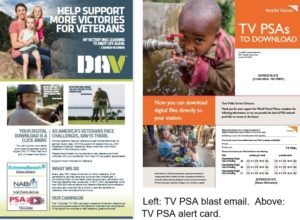 The promotional techniques to be used will differ by media type. Most broadcasters indicate that phone calls to encourage PSA usage are a nuisance unless they are handled properly and provide something of inherent value to the station. (See the question below dealing with Telemarketing). There are a variety of other things we do to promote a client’s PSA including:
The promotional techniques to be used will differ by media type. Most broadcasters indicate that phone calls to encourage PSA usage are a nuisance unless they are handled properly and provide something of inherent value to the station. (See the question below dealing with Telemarketing). There are a variety of other things we do to promote a client’s PSA including:
- Sending pre-campaign alerts and blast emails to stations
- Getting client PSAs posted on the National Association of Broadcasters’ Spot Center
- Contacting the broadcast and cable networks to pitch your PSA to them
- Sending follow-up reminders
For other media, we rarely do any type of promotion because the decision-making process is much more diffused, making productive follow-up contacts very difficult. Also, since TV contributes most of the campaign exposure – typically 85% – it is best to focus attention on that medium. You can read more details at: www.psaresearch.com/biboverall.html#prom
It depends upon the type of medium. Typically, as noted above, local broadcast stations regard pitch calls from the national level, as a nuisance and will not be productive for the following reasons:
First, there is the issue of cost. Our experience shows you must make a minimum of three calls to get one successful connection with the appropriate individual at the station.
Secondly, stations are being bombarded with these type of calls, and most of them use voice mail to screen calls. If it is the same old survey, asking the same tired old questions, they simply won’t respond.
If you must do telemarketing, find a way to engage the public service director in some meaningful way. One way to do it, is to have someone from the local community make the calls, because it will mean a lot more than calls placed from a national telemarketing firm or from national staff.
Third, try to emphasize the importance of the problem or solution being offered by your PSA in local terms. Cite local statistics and how the station can help solve the problem locally. If your PSA promotes literature or a website, send samples to the public service director so they can see what will be sent to their viewers. Having made these points, there are a few areas where telemarketing can be very effective including national TV networks and outdoor companies.
Replication/Distribution
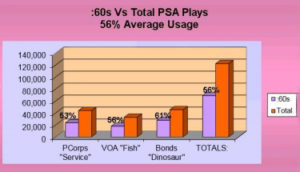 Ideally at least three – :15/:30/:60 in both TV and radio. The key to getting good placement of PSAs is to provide the media as much
Ideally at least three – :15/:30/:60 in both TV and radio. The key to getting good placement of PSAs is to provide the media as much
flexibility as you can, because it increases the chance that your PSA will get used when there is un-sold time available.
And don’t overlook sixties for TV…yes we said sixty-second TV spots. Nielsen SpotTrac data indicates that when a :60 is included in the mix, they are used from 56-72 percent of all PSAs aired.
It sounds too good to be true, but that’s what the data indicates consistently from one campaign to another. Obviously longer length PSAs are worth a lot more than other shorter lengths and contribute significantly to higher dollar values, which is an important
part of campaign evaluation.
And perhaps most importantly, you can communicate a much more compelling message with longer length PSAs, particularly if you have to register an 800 phone number or website in the tag which can take ten seconds just by itself.
In terms of TV digital distribution costs, you can send six HD and six SD formats to stations for a blanket cost. Any additional PSAs will double your cost and perhaps more importantly there is a limit to how many the media will use. If you have a large number of PSAs on hand, consider distributing them in waves, rather than all at once.
View the article that addresses this question at: PSA Producer’s Guide.
As with many things in life, you get what you pay for. In a few cases of which we are aware such as the Partnership for a Drug-Free America, PSAs can be distributed successfully using internal resources, but they have spent years developing local coalitions which help them get PSAs to stations.
There are a variety of things to consider in PSA distribution above and beyond just having a media list. For example, you need to know how digital distribution works, how to promote your campaign and how to prepare your materials so they will get used.
Next, you need to know who the decision-maker is at all the media outlets you are targeting – typically over 10,000 individuals if you are doing a multi-media campaign. You have to have a list of all the national networks, which can generate a substantial level of PSA exposure.
Finally, there are complex evaluation procedures that require sophisticated reporting software to provide meaningful results.
A professional distribution service offers these services, and can handle all the other details associated with getting a campaign out to the right person at the right time and in the right format saving valuable internal resources.
If you were to include all your costs – including staff time – to do the job internally and weigh that against what you get in media exposure, professionally distributed campaigns are probably a better value. Finally, a good distributor will help guide you through the entire process of PSA campaign development, from positioning your issue to placement.
For more information, including a graph showing results of campaigns that have been
re-released, go to: Recycling PSAs.
When the PSAs are distributed, we send instructions to the Traffic Director asking them to forward the digital files to the public service or community affairs director. We also send blast emails and a postcard to public service directors with links to download sites as a backup procedure. Finally, we get confirmation reports from our digital distribution partner when PSAs have been downloaded.
What we call the “big four” broadcast networks (ABC, CBS, NBC and Fox) almost never use externally produced PSAs. For the most part, they create internal PSAs with their on-air actors to address social issues because that allows them to “brand” the spots.
Very, very rarely we have been able to get a client PSA to air on a national network and its affiliates, but it is getting less frequent all the time with the number of paid commercials increasing.
The digital distributor we use has a very comprehensive list of Spanish TV outlets and they are handled the same way as English PSAs except they are distributed to only Spanish stations. It is helpful to also include Spanish copy on any promotional materials directed to Spanish stations
At a minimum, a four-color storyboard, a newsletter or fact sheet, and traffic instructions, all in .PDF format which are posted to the digital distribution platform along with the actual files
The key contact is different depending on the medium. For television, there may be several people who typically make the PSA decision, depending upon the size of the station and their community affairs policy. It is either the Public Service Director, the Director of Community Affairs, or the Program Director. At smaller stations the General Manager may be the contact person. The GM usually has a heavy influence on program
policies, regardless of size.
At radio stations the decision-making is more diffused, and again, it depends upon the size of the station. Larger stations will likely have a Public Service Director, but at smaller stations the Program Director, Station Manager, and perhaps even the Engineer or disk jockey could get involved in putting your PSAs on the air.
While most any time of the year is appropriate given the long shelf life of a typical PSA campaign, there are some times that are better than others and it also differs by medium. For TV, there is generally more time available in the first half of the year in terms of unsold inventory, particularly the first quarter. However, that is also when more organizations distribute PSAs, so things could be a little tight until new releases are absorbed into the station’s system.
For radio, summer is when there are more people out of home and in their cars so that is a good time to distribute a campaign, particularly if you are trying to reach young people.
For all media, the fourth quarter, particularly right after the Thanksgiving holiday is not the best time to distribute PSAs, due to the heavy paid schedules prior to Christmas. Perhaps the most optimum time is the week immediately after Christmas because it is a very slow sales period among the media, and you can pre-empt other organizations that will be distributing their campaigns at the first of the year.
Also, it is a good idea to tie the release of your campaign in with other promotional activities and special community events such as the Race for the Cure, the MS Walkathon or Earth Day. The media often focuses editorial attention on these issues, which can reinforce the impact of your PSAs.
For the most part, we stopped recommending print PSAs in early 2016, because most magazines and newspapers had declining readership, which resulted in smaller publications and less space for PSAs. We believe the money spent on print PSA distribution could be better spent in other media.
Due to the high cost of producing outdoor billboard paper and other unique attributes, outdoor needs to be handled very differently than other kinds of media. Our approach is to solicit the media on the types of sizes and quantities they will use prior to producing outdoor signage and then fulfill orders based on usage agreements. We have completed this type of placement effort for a number of clients with considerable success. To view articles explaining the growth of outdoor and placement venues, go to: www.psaresearch.com/biboverall.html#out.
Evaluation
Once the code is embedded on the master, it is then replicated on digital files distributed to TV stations. Nielsen has monitoring equipment in all 212 DMAs around the country, and when the PSAs are aired, Nielsen’s monitoring system is able to track exact time usage of the PSA. The data from that usage is then fed to our computer, we add value to their data and report value-added PSA usage.
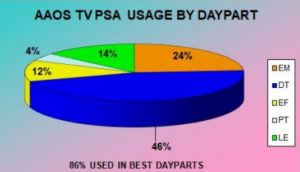 Various studies, particularly data from the Nielsen SpotTrac system show that in one campaign after another, the majority (from 50-65%) of all PSAs air in the more desirable dayparts – from 7 AM to 11:30 PM.
Various studies, particularly data from the Nielsen SpotTrac system show that in one campaign after another, the majority (from 50-65%) of all PSAs air in the more desirable dayparts – from 7 AM to 11:30 PM.
A benchmark composite showing usage from seven different PSA campaigns showed that on average, 56% of all PSAs aired in these dayparts. You may say that with so many working women today, PSAs that air during the day don’t reach enough people. But if that is true, Proctor and Gamble should fire their advertising agency, because they buy a lot of paid spots during this time.
However, if delivering impressions to an audience, getting people to phone, visit a website, or getting volunteers are your goals, there is ample evidence that PSAs can meet these objectives. Go to the Articles section and then read articles devoted to evaluation and campaign effectiveness at: www.psaresearch.com/biboverall.html#eva
Obviously there are many different factors that affect how much usage any given PSA campaign will receive. These include the relevancy of the issue, time of year it is released, media awareness of your issue, your budget, how the PSA was distributed, promotional activity, creative quality and which media you use just to name a few.
Assuming a multi-media approach and professional distribution, the following benchmark data is taken from dozens of campaigns we have distributed.
On average a broadcast TV PSA itself will generate exposure in 166 markets on 213 stations and 13,000 airplays for six months.
If our cable distribution service is included in the distribution plan, cable usage will add 11,000 more airplays on average to the total. For radio, you can expect to have your PSAs used more than 20,000 times on nearly 300 stations.
Also, the length of time you monitor your campaign can have a significant impact on values. The number of broadcast TV airplays on average increases to 22,000 if you extend monitoring of your campaign for twelve months.
Extending Nielsen tracking is one of the most cost-effective things you can do to extract more value from your campaign because it costs less to extend tracking than for the initial tracking. The following graph shows the results of tracking at different periods.
Yes there is an electronic tracking procedure offered by Nielsen which tracks PSA usage on 2,200 radio stations in major markets. It uses passive monitoring technology, meaning that there is no code that has to be embedded on the creative master such as the case with the Nielsen TV tracking system. The downsides are that it is expensive and only covers approximately 20% of the radio universe.
Miscellaneous Questions
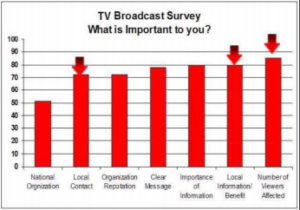 In various sections of our FAQs, we address this question, but to succinctly restate
In various sections of our FAQs, we address this question, but to succinctly restate
the factors that affect usage, they include:
- Available inventory. In larger broadcast markets, there is less time available due to more paid sponsors and more demand for the best dayparts.
- Creative quality – it has to be very good to get on the air. The issue or focus of the PSA (health, safety, emergencies and environmental issues) typically perform better than others. The time of year they are distributed (fourth quarter is
worst). - Flexibility in terms of spot length (more is better). How well the campaign is promoted. The number of stations targeted and the quality of the distribution process – targeting the right person and sending the right formats to stations.
- The number of TV networks you target and how you collaborate with them.
- Last, but definitely not least, is the local impact of your PSAs as shown in this graph. The data was taken from a survey of 1,000
broadcast TV public service directors with a 72% response rate.
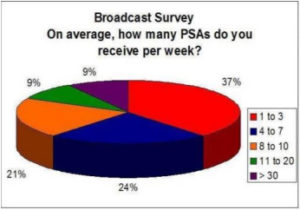 In the same survey referenced above, stations were asked how many PSAs do they receive weekly and as shown by the graph, 39% of them indicated they get from 8-30 PSAs a week.
In the same survey referenced above, stations were asked how many PSAs do they receive weekly and as shown by the graph, 39% of them indicated they get from 8-30 PSAs a week.
In another survey conducted by the National Association of Broadcasters, stations reported using 143 PSAs weekly, or 572 per month. Annually, when extrapolated, the number of annual “avails” ranges from 2016 to 6,864 depending upon whose data is being used.
Health, safety, the environment, veteran’s issues are all popular, and anything you can do to localize your issues will be helpful as shown by the previous graph.
If your issue doesn’t fit one of these categories, think about a different spin, or position your issue differently to make it more acceptable and topical. For example, if you develop programs for overseas development, try to focus on the domestic and local benefits in your campaign, which we recommended to the Peace Corps and it made a significant difference in impact.
If there is any way to portray and depict children in your TV PSA, take that route. Due to the Children’s Television Act, stations are clamoring for good children’s programming because the FCC requires stations to air a certain number of hours of positive children’s programming.
The short answer is no, and they never were, but this question deserves a more detailed explanation. In spite of a very widespread misperception, stations were never mandated to use a prescribed level of PSAs. What they are required to do is to broadcast in the ‘public interest.’ Along with airing PSAs, stations can use a variety of programming to meet FCC requirements, including community calendars, editorials, specials on a community issue, and participating in community events.
However, there is one issue where the FCC does mandate a prescribed level of public interest programming, which is called the Children’s Television Act, but again, PSAs are not the only way for broadcasters to meet this requirement. The Act calls for every fullservice TV station to air at least three hours per week of “core educational programming,” which is defined as “serving the educational and informational needs of
children as a significant purpose.”
They must be aired between the hours of 7 a.m. and 10 p.m.; be a regularly scheduled weekly program; and be at least 30 minutes in length. Stations also have reporting requirements to prove they are meeting this mandate.
Also, remember cable TV is not regulated by the FCC, so their obligations to the public interest are very different, and they are much more flexible in the types of programming they use.
The ideas are boundless, if there is an ample promotional budget. Some clients stage press conferences, others send out pre-campaign mailers, some stage local events to which the media are invited, some try to have local community partners call stations, and still others use non-PSA techniques such as social media – Facebook, Twitter and You Tube – to reinforce their PSA message. Also see the section which provides more ideas on how to promote your campaign.
The Ad-ID Code is is a Web-based system that generates a unique identifying code for advertising messages to help identify them across all media platforms. To get your PSAs used on national cable networks, you must have an AD ID code and it is also required for digital distribution.
There is no cost to get the code for a non-profit 501(c)(3) organization, but government agencies must pay a small fee. To initiate the process, the producer should send an email to: cs@ad-id.org with a copy of their determination letter from the IRS. The email subject must contain “Non-Profit” and Name of Advertiser. For questions or further assistance, call AD-ID customer service at (704) 501-4410
